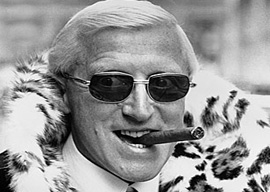
November 05, 2012

Jimmy Savile
And then on October 3, ITV screened Exposure: The Other Side of Jimmy Savile. The program alleged molestation of ten women, one of whom had been 14 at the time. And then the floodgates of reminiscence opened”sordid tales of gropes and rapes and cover-ups carried out over decades. It seemed that the BBC had shelved a similar documentary almost a year beforehand. We who had always seen Savile as a bizarre-looking benefactor suddenly saw in plain view things that had always been hidden. He had even bragged about some of his exploits in his autobiography. We learned that there had always been mutterings about his vanity and his strangely solitary life. It seemed there had always been hints of roaming hands, winks, and jokes, as well as complaints about liaisons in unlikely places with very young girls. Wiser charities, including the BBC’s own Children in Need, had always kept him at bay. In 1991, psychologist Anthony Clare described him as “a man without feelings,” and on a 2000 documentary he admitted that when working as a nightclub manager he had beaten and incarcerated people. In 2007, police quizzed him about abuse at a girls” home; in 2008, he sued The Sun over similar allegations.
Now, with all threat of libel action removed, many have come forward to say they had once been targeted”including bedridden girls and Boy Scouts. He wore tracksuits, they said with a shiver, because it was quick to pull them down and up again. In late October, Scotland Yard said there may have been as many as 300 victims, and the allegations had encompassed the whole BBC and several coeval celebrities including Gary Glitter, actor Leonard Rossiter, and alleged comedian Freddie Starr. The BBC Director-General apologized for what seems to have gone on, and the BBC set up three internal inquiries to examine their sexual culture at the time. Even the Eric Gill statues on the BBC building in Portland Place have been dragged into the dock. Inquiries are also afoot at the Department of Health and the Crown Prosecution Service.
Before a single allegation has been taken to court, let alone proved, there is wild talk of stripping his knighthood, his houses have been daubed with “paedophile,” “rapist,” and “beast,” and his £4-million estate has been frozen. There has already been an expunging of his memory”the closure of two charities, removal of a statue, renaming of a footpath and a conference center, destruction of his gravestone, and removal from the BBC website of an episode of Desert Island Discs.
Still the ripples roll outward, with the BBC reviving old rumors about a high-profile Conservative politician, MPs asking about supposed sex rings in Downing Street, and columnists agonizing over what-it-tells-us-about-men-and-society. “The evil of Jimmy Savile was not his alone,” intoned Jonathan Freedland on October 12, talking of “the devil who tries, and succeeds, in passing himself off as a saint.” To him, Savile was an exemplar of the old abusive Adam, similar to child-abusing priests and the (Asian) gang who targeted (white) Rochdale girls. The police should take sex abuse more seriously, but first:
Some wonder if the Met is overdue another “Macpherson moment,” in which it is forced to confront its own institutional sexism the way the Stephen Lawrence case laid bare its racism.
But what should really bother Freedland is not police imperfection but human imperfection”and the cultural chaos released by the shallow, sexualized pop culture the unlamented Leeds longhair personified. Savile was a Neanderthal in the guise of a modern”but then in a way we all are.